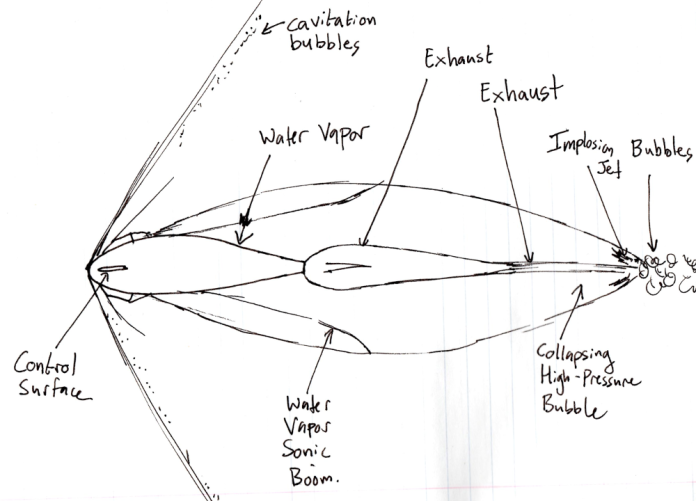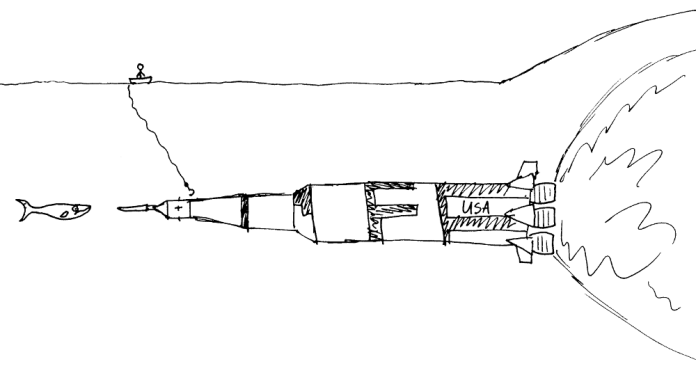There’s an old joke. A mathematician and an engineer die in a car crash and go up to Heaven. They meet Saint Peter up there, and he leads them to a mile-long hallway with a big pearly door with a gold handle at the other end. Saint Peter says “Both of you have done good things and evil things in your lives. To test if you’re inherently good-natured and worthy of getting into Heaven, I’m going to put you through a challenge. Whenever I sound my trumpet, you’re allowed to walk half the remaining distance to the door. If you get to the door, you can open it and go to Heaven. But if you move more than I tell you to, or try to cheat, you’ll go to Hell.”
The two guys confer for a second. The mathematician says “It’s a trick. We’re going to Hell anyway: no matter how many times you divide the distance in half, it’ll never be zero. We’ll never actually reach the door.”
They don’t get a chance to say anything else: Saint Peter sounds his trumpet. Both guys walk half a mile, to the middle of the hallway. The mathematician is getting antsy. Saint Peter sounds his trumpet again, and they walk a quarter-mile. He sounds it again: they walk an eighth of a mile. Again: 330 feet. Again: 165 feet. By now, the mathematician’s shaking and sweating and turning beet-red. The engineer starts to say something to him, but the mathematician screams and starts running back the way he came. He doesn’t get ten paces before a hole opens beneath him and he falls into a pit of fire and brimstone.
After Saint Peter’s sounded his trumpet ten times, the engineer’s only a foot or so from the door. He turns back and looks at Peter and says “Is it all right if I reach out and turn the handle?” Saint Peter says “Of course.” The engineer opens the door. On the other side is Heaven, full of angels on clouds and such. Saint Peter says “Well, you opened the door. Go ahead and walk through.” The engineer walks through Saint Peter goes with him and says “One warning, though: all our rulers are warped, our T-squares are crooked, and our compasses are made out of rubber.” The engineer thinks for a second and says “I see. Look, is it still possible for me to go to Hell? Have they got an opening?”
…
That joke is one of the many warped forms of Zeno’s Paradox. It should be impossible to reach any destination, since first you have to cover half the distance, and then you have to cover a quarter of the distance, and then an eighth, and so on, and you never actually arrive. Well, I’m going to take that literally. I’m going to imagine traveling from the west coast of the United States (specifically, from The Riptide bar and honky-tonk on Taraval and 47th, in San Francisco, California) to the east coast (specifically, to the parking lot of the Holiday Inn in Wrightsville Beach, North Carolina). That’s a distance of 4,014 kilometers. I’m going to imagine covering that distance in the same fashion as in that joke: covering half the remaining distance each time. I’m going to move once every ten seconds.
1/2
I travel 2,007 kilometers in 10 seconds. I’m traveling at about 201 kilometers per second, meaning I carve a ram-heated plasma trail through the air, setting a swath of the United States on fire as I travel. If I were human (which I’m clearly not, if I’m doing this kinda shit), I’d be pulped by the acceleration required to follow the curvature of the Earth at these speeds. I stop not too far from Dodge City, Kansas. Good thing I already have to move again, because I’m pretty sure there’s an angry mob gathering.
1/2 + 1/4 = 3/4
I travel 1,003.5 kilometers in 10 seconds. I’m still setting fire to every object I pass, blinding bystanders, and knocking down trees and buildings with my shockwave. I’ve broken every window in Wichita, Kansas and Springfield, Missouri. I pause, momentarily, in the westernmost tip of Kentucky. If I were human, I’d still have been pulped by the acceleration.
1/2 + 1/4 + 1/8 = 7/8
I travel just under 502 kilometers in 10 seconds. I’m moving as fast as some of the fastest shooting stars, but at ground level. I’m wrecking everything I pass in a way the Chelyabinsk meteorite could only aspire to. My shockwave and fireball cause burns, injuries, and structural damage in Knoxville and Nashville. I scream over the Blue Ridge Mountains and stop just short of Asheville, North Carolina, which I’ve been to, and which is a nice town.
1/2 + 1/4 + 1/8 + 1/16 = 5/16
I travel 251 kilometers this jump. The centripetal acceleration required to follow the curve of the Earth is an almost-survivable 10 gees. I’m still meteoric, though, blasting through Asheville, narrowly missing Gastonia, and ruining the lives of everyone in south Charlotte. I stop not far past Charlotte. I didn’t plan it this way, but I’ve visited my hometown on my accidental rampage.
31/32
I travel 125 kilometers. Still fast enough to cause a hell of a shockwave and probably a bit of a plasma trail, but now I’m only going as fast as a high-velocity railgun projectile. To stick to the Earth, I have to accelerate downwards at 2.5 gees, which is very much survivable, especially for only ten seconds. I stop not far north of Lumberton, North Carolina, which I’ve never visited, but I’ve heard is another nice little town. We’ve got a lot of those in North Carolina, actually. It’s kinda cool.
63/64
I travel roughly 63 kilometers in 10 seconds. I’m moving at the speed of a very ambitious bullet. My centripetal acceleration is just over half a gee. I stop in a track of farmland with not much around me.
127/128
This jump covers 31 kilometers at the speed of a sniper-rifle bullet. My acceleration is 0.15 gees, which is the kind of acceleration people experience in cars on a regular basis. I’m not far outside the city limits of Wilmington, NC, in the woods between a church and a water treatment plant (according to Google Earth.)
255/256
I’m still moving like a bullet, covering 15.7 kilometers in 10 seconds. I stop over a river in Wilmington’s northern outskirts, near a drawbridge and what looks like an oil-tank complex.
511/512
I travel 7,839 meters in 10 seconds, which brings me down to the muzzle velocity of an ordinary handgun. I come to a stop on the roof of a Home Depot in Wilmington.
1023/1024
This jump is 3,920 meters at around Mach 1. I’m still probably bursting eardrums wherever I pass, but those newly-deaf people should count themselves lucky: there’s a lot of people burned to ash on the West Coast.
2047/2048
1,960 meters at the speed of an ordinary airplane. I stop in a marsh on the bank of the estuary that separates Wrightsville Beach from Wilmington. People are no longer being injured by my passage, but they’re probably pretty horrified to see a human being moving this fast. Plus, it’s been over a minute and 45 seconds since my accidental rampage began. That’s probably fast enough for people to post pictures of my path of destruction on Twitter.
4095/4096
I only travel 979.911 meters this time at an almost-sensible 219 mph (352 km/h). I manage to cross the estuary, although I’m still in the damn marsh, not yet to Wrightsville Beach. I stop near what, on Google Maps (on November 27th, 2016, anyway) looks like a horrifying half-mile long translucent river-worm:

Some may say it’s just a boat wake. I say they’re just blinding themselves to the truth that Big Google Data Brother Government Conspiracy (LLC) is trying to hide from the people. That’s what you’re supposed to say when you find weird shit in Google Earth, right?
8191/8192
I’m still going way over the posted speed limit as I cover the next 489.956 meters. Still stuck in this damned marsh, too.
16383/16384
A 244.978-meter jump at a sensible 54 mph (88 km/h). I’m starting to feel a little like the mathematician in the joke: all of a sudden, things are moving painfully slow.At least I’m out of the stupid marsh, and passing through a fairly pleasant-looking seaside housing development.
32767/32768
122.489 meters covered at a very pleasant 27 mph (44 kph). I’m almost within the ordinary residential speed limit! I’m only a block from the Holiday Inn, so tantalizingly close. I must persevere! I wanna be the engineer in the joke, not the mathematician! Hell sounds terrible!
65535/65536
A nice neat number. 2^16. 10000000000000000, in binary. I travel 61.244 meters. Less than the length of any sort of football field. I’m moving at 6.1 meters per second. A decent sprinter could manage that. Usain Bolt could most certainly manage that.
131071/131072
30.522 meters this time. I’m jogging across the parking lot, almost a literal stone’s throw from the Atlantic.
262143/262144
15.311 meters covered this jump, and 15.311 left to go. I can look into the windows of the Holiday Inn, and see all the employees on their phones reading about the carnage in California.
524287/524288
7.656 meters. A man passing me in the Holiday Inn parking lot wonders why I’m walking so damn slow.
1048575/1048576
3.828 meters. I’m walking at less than 1 mile per hour, which feels really weird when I do it in real life. I’m starting to regret many decisions. Plus, people are starting to get suspicious of me.
2097151/2097152
1.914 meters left to go. If I fell flat on my face (which is starting to seem like a good idea…), my head would push the front door open.
1 – 2^(-22)
Less than a meter to go. As I stand almost within arm’s reach of the hotel’s front door, people are giving me looks usually reserved for those who start talking about lizard people at bus stops.
1 – 2^(-23)
Half a meter. Finally–finally–I can reach out and push the door open. And thus, my bizarre trip comes to an end. I’ve covered 4,013,716.5 meters in about 3 minutes and 45 seconds. I’ve killed many, many people and injured countless others. There will be an investigation. Even though this isn’t exactly the sort of thing the FBI is used to, they’ll probably do their damndest to figure out just who or what set the west coast on fire, smashed millions of windows, and made a sonic boom over North Carolina. There’s probably enough security camera evidence to find me. Until then, I’ll just catch some sun on Wrightsville Beach.




